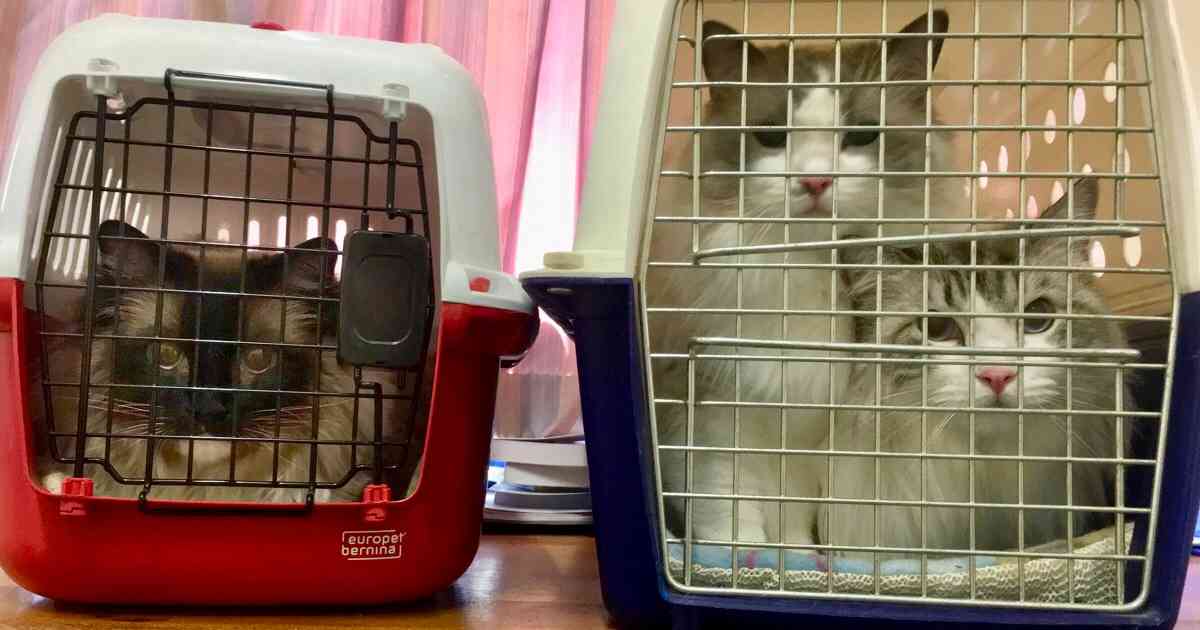Updated November 28, 2020
So often when an owner says “I can’t get my cat in the carrier” I think “It’s no wonder with the one you’ve got”. Then other times I see cat carriers completely fail and put cats at risk.
Here’s our guide to buying a cat box that’s not only easy to use but safe to be in.
Why Use A Cat Carrier?
- Cats are highly territorial and get distressed when taken out. A cat box gives them a little piece of home to hide in.
- Cats are impossible to hold when they panic, as happens a lot during transport.
- Cat boxes protect cats from other animals, especially dogs.
- Cats unrestrained in a car are a great danger both to people and themselves.
Now let’s look at what makes a good cat box.
Choosing A Good Cat Carrier
A good cat box should:
- Be strong and sturdy but not too heavy
- Have a large front opening
- Have the option of opening the top
- Have a secure latch
- Be conveniently separatable into two halves
- Be easy to clean & not have fabrics or zippers
- Be big enough that your cat can stand and turn
- Be well-stored and maintained
Now let’s look at the two examples above.
Strength
Both are good quality, well-made and not too heavy to lift.
Tips when buying: push and pull the cat box to put it under stress. The two halves should fit well together. the door should stay closed with a click, and the whole box should not rock, bend or distort easily.
Those cheap flatpack cat boxes made from cardboard or corflute are only good for the ride home from the shelter. Cats can easily use their claws to break out once they get bigger.
Front Opening
The opening of the red box is a little small for an uncooperative cat.
Tips when buying: The blue box shows how the opening should be nearly the size of the front. There are no flanges that the cat can wedge their feet against.
Top Opening
Neither has an opening top. These are better for difficult cats, as you’ll see in the video.
Tips when buying: Top hatches need to shut very securely as it’s on these that the handle attaches.
If the hatch is large, or the whole top of the cage is wire, your cat won’t like the exposed feeling. I recommend making a cover from a towel by cutting a slit so the handle fits through.
Secure Closure
The blue box has a difficult catch; can you see it’s actually not fully latched? The red box has a (good) standard IATA airline approved catch.
Tips when buying: close the latch and pull on the door to see how secure it is.
Disassembly
Both are easy to separate into their two halves if needed (useful as a last resort to get the cat in or out). The blue box has thumb screws, the red box has plastic catches.
Tips when buying: trial disassembly in the store (if you feel bad, remember this was how they were shipped). You won’t regret finding out now that the box is a nightmare to reassemble.
In particular, note that doors like on the red one above need to be open when you put the lid on- not ideal if you’ll need to pull the box apart to get your cat in.
Easy Clean
Nearly all plastic cat carriers are lightweight and easy to clean, so we only recommend these. Velcro and zippers are also far too insecure for transport.
Size
The blue box is the correct size, whereas the red box is only suitable for a short trip with a cooperative cat.
Maintenance
Both boxes have been well looked after by storing in a clean, dark place. Beware leaving a cat carrier out in the sun as the plastic will become brittle. These are best replaced before the handle breaks off when you pick them up.
One or Two Cats In A Box?
As for having two cats in one, it’s not ideal. They need to be best mates (these two are brother and sister), but even then it’s quite cramped and very difficult to lift safely. It also puts a lot of stress on the handle.
I hope this helps you choose the best cat carrier.
Now you might need to visit our page on getting your cat into the box!
Related: Travelling with cats in cars
Have something to add? Comments (if open) will appear within 24 hours.
By Andrew Spanner BVSc(Hons) MVetStud, a vet in Adelaide, Australia. Meet his team here.

